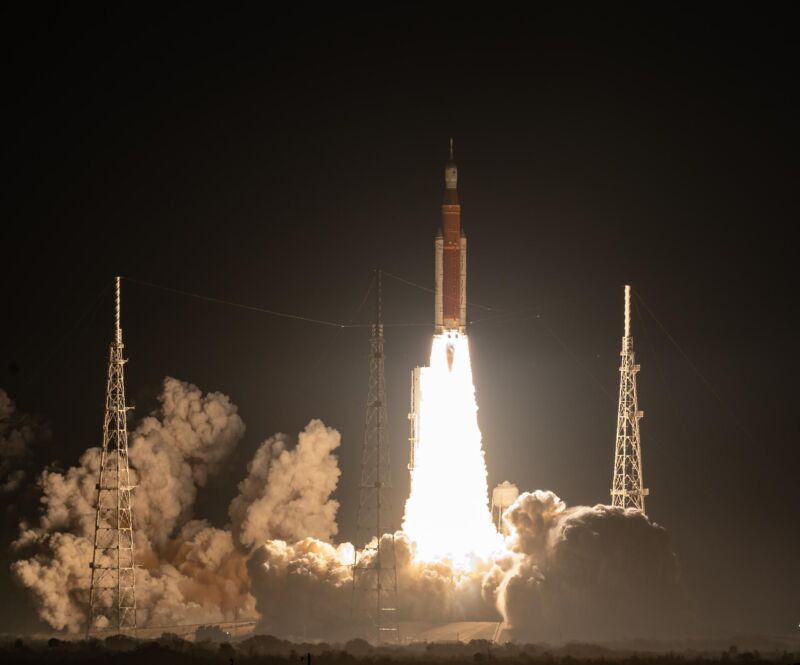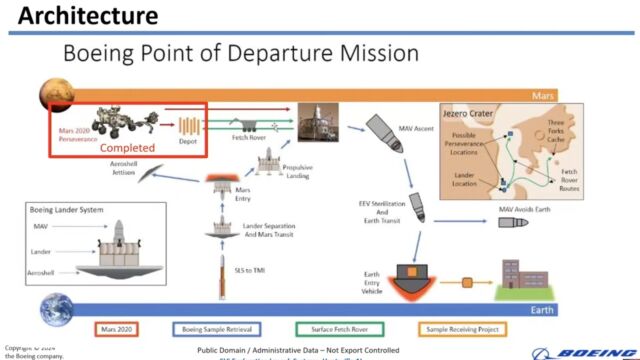
Enlarge / The Space Launch System rocket lifts off on the Artemis I mission.
NASA is looking for ways to get rock samples back from Mars for less than the $11 billion the agency would need under its own plan, so last month, officials put out a call to industry to propose ideas.
Boeing is the first company to release details about how it would attempt a Mars Sample Return mission. Its study involves a single flight of the Space Launch System (SLS) rocket, the super heavy-lift launcher designed to send astronauts to the Moon on NASA’s Artemis missions.
Jim Green, NASA’s former chief scientist and longtime head of the agency’s planetary science division, presented Boeing’s concept Wednesday at the Humans to Mars summit, an annual event sponsored primarily by traditional space companies. Boeing is the lead contractor for the SLS core stage and upper stage and has pitched the SLS, primarily a crew launch vehicle, as a rocket for military satellites and deep space probes.
All in one
Green, now retired, said the concept he and Boeing engineers propose would reduce the risks of Mars Sample Return. With one mission, there are fewer points of potential failure, he said.
“To reduce mission complexity, this new concept is doing one launch,” Green said.
This argument makes some sense, but the problem is SLS is the most expensive rocket flying today. Even if NASA and Boeing introduce cost-cutting measures, NASA’s inspector general reported last year it’s unlikely the cost of a single SLS launch would fall below $2 billion. The inspector general recommended NASA consider buying commercial rockets as an alternative to SLS for future Artemis missions.
NASA’s Perseverance rover, operating on Mars since February 2021, is collecting soil and rock core samples and sealing them in 43 cigar-size titanium tubes. The rover has dropped the first 10 of these tubes in a depot on the Martian surface that could be retrieved by a future sample return mission. The remaining tubes will likely remain stowed on Perseverance in hopes the rover will directly hand off the samples to the spacecraft that comes to Mars to get them.

Enlarge / Boeing says a single launch of the Space Launch System rocket could carry everything needed for a Mars Sample Return mission.
Boeing
In his remarks, Green touted the benefits of launching a Mars Sample Return mission with a single rocket and a single spacecraft. NASA’s baseline concept involves two launches, one with a US-built lander and a small rocket to boost the rocket samples back off the surface of Mars, and another with a European spacecraft to rendezvous with the sample carrier in orbit around Mars, then bring the specimens back to Earth.
“This concept is one launch vehicle,” he said. “It’s the SLS. What does it do? It’s carrying a massive payload. What is the payload? It’s a Mars entry and descent aeroshell. It has a propulsive descent module.”
The lander would carry everything needed to get the samples back to Earth. A fetch rover onboard the lander would deploy to drive out and pick up the sample tubes collected by the Perseverance rover. Then, a robotic arm would transfer the sample tubes to a container at the top of a two-stage rocket called the Mars Ascent Vehicle (MAV) sitting on top of the lander. The MAV would have the oomph needed to boost the samples off the surface of Mars and into orbit, then fire engines to target a course back to Earth.
Boeing has no direct experience as a prime contractor for any Mars mission. SpaceX, with its giant Starship rocket designed for eventual Mars missions, and Lockheed Martin, which has built several Mars landers for NASA, are the companies with the technology and expertise that seem to be most useful for Mars Sample Return.
NASA is also collecting ideas for Mars Sample Return from its space centers across the United States. The agency also tasked the Jet Propulsion Laboratory, which was in charge of developing the original dead-on-arrival concept, to come up with a better idea. Later this year, NASA officials will reference these new proposals as they decide how to proceed with Mars Sample Return, with the goal of getting samples back from Mars in the 2030s.